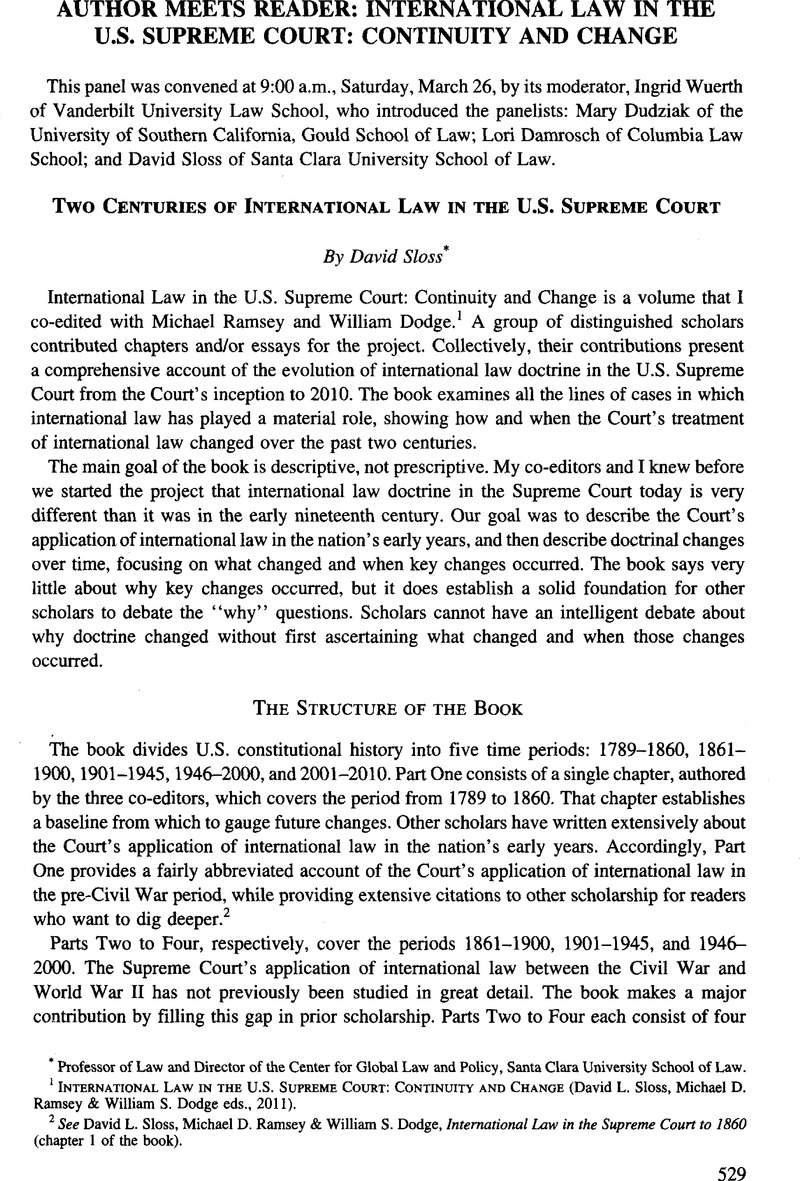No CrossRef data available.
Article contents
Two Centuries of International Law in the U.S. Supreme Court
Published online by Cambridge University Press: 28 February 2017
Abstract

- Type
- Author Meets Reader: International Law in the U.S. Supreme Court: Continuity and Change
- Information
- Copyright
- Copyright © American Society of International Law 2011
References
1 International Law in the U.S. Supreme Court: Continuity and Change (David L. Sloss, Michael D. Ramsey & William S. Dodge eds., 2011).
2 See Sloss, David L., Ramsey, Michael D. & Dodge, William S., International Law in the Supreme Court to 1860 (chapter 1 of the book)Google Scholar.
3 See Duncan B. Hollis, Treaties in the Supreme Court, 1861-1900 (chapter 2); Michael P. Van Alstine, Treaties in the Supreme Court, 1901-1945 (chapter 6); Paul B. Stephan, Treaties in the Supreme Court, 1946-2000 (chapter 10).
4 See David J. Bederman, Customary International Law in the Supreme Court, 1861-1900 (chapter 3); Michael D. Ramsey, Customary International Law in the Supreme Court, 1901-1945 (chapter 7); William S. Dodge, Customary International Law in the Supreme Court, 1946-2000 (chapter 11).
5 See Thomas H. Lee & David L. Sloss, International Law as an Interpretive Tool in the Supreme Court, 1861- 1900 (chapter 4); Roger P. Alford, International Law as an Interpretive Tool in the Supreme Court, 1901-1945 (chapter 8); Melissa A. Waters, International Law as an Interpretive Tool in the Supreme Court, 1946-2000 (chapter 12).
6 See John Fabian Witt, A Social History of International Law: Historical Commentary, 1861-1900 (chapter 5); Edward A. Purcell, Jr., Varieties and Complexities of Doctrinal Change: Historical Commentary, 1901-1945 (chapter 9); Martin S. Flaherty, Global Power in an Age of Rights: Historical Commentary, 1946-2000 (chapter 13).
7 See Lori F. Damrosch, Medellin and Sanchez-Llamas: Treaties from John Jay to John Roberts (main essay); Julian Ku, The Benefits of Avoiding Conflicts Between the Constitution and International Law (response); David L. Sloss, Medellin and the Passive Vices (response).
8 See John O. McGinnis, Sosa and the Derivation of Customary International Law (main essay); Olimene Keitner, “Cheap Talk” About Customary International Law (response); Edward A. Purcell, Jr., History, Ideology, and Ene v. Tompkins (response).
9 See Mark Tushnet, International Law and Constitutional Interpretation in the Twenty-First Century: Change and Continuity (main essay); Roger P. Alford, Why Constitutional Comparativism it Different: A Response to Professor Tushnet (response); Melissa A Waters, Judicial Dialogue in Roper: Signaling the Court’s Emergence as a Transnational Legal Actor (response).
10 See Ralf Michaels, Empagran’s Empire: International Law and Statutory Interpretation in the U.S. Supreme Court of the Twenty-First Century (main essay); William S. Dodge, Loose Canons: International Law and Statutory Interpretation in the Twenty-First Century (response); Paul B. Stephan, Empagran: Empire Building or Judicial Modesty? (response).
11 See David Golove, The Supreme Court, the War on Terror, and the American Just War Constitutional Tradition (main essay); Martin S. Flaherty, Constitutional Resolve in a World Changed Utterly (response); Michael D. Ramsey, Judicial Imperialism and the War on Terror Cases (response).
12 278 U.S. 123 (1928).
13 539 U.S. 558 (2003).
14 See Tashiro, 278 U.S. at 127-30.
15 See Lawrence, 539 U.S. at 573-77.
16 In 1928, when Tashiro was decided, the Court’s equal protection jurisprudence was not especially favorable for non-citizen plaintiffs. However, at least since its decision in Graham v. Richardson, 403 U.S. 365 (1971), the Court has construed the Equal Protection Clause to impose strict constraints on a state’s ability to discriminate against aliens.
17 For further elaboration of this point, see Sloss, David, Using International Law to Enhance Democracy, 47 Va. J. Int’l L. 1, 17-20 (2006)Google Scholar.
18 The Court in Lawrence relied primarily on decisions of the European Court of Human Rights which applied a European human rights treaty to which the United States is not party. See 539 U.S. at 573-77.




